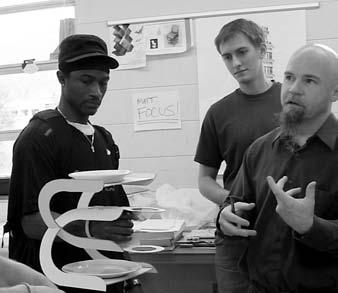
4 minute read
Graphic Design Student Helps Launch Wolfgrid
Since early in 2004, graphic design graduate student Jon Harris has had a hobby that requires most of his extra time.
Armed with a BFA in graphic design with an undergraduate minor in electrical engineering from The Cooper Union for the Advancement of Science and Art, Harris is now a fourth-semester graduate student. He has always been interested in the space where art and design and technology meet. His membership in the Mac Users Group on campus led to his interest in creating a supercomputer at NC State. When Apple released its Xgrid software in January 2004, the Mac Users who were interested started Wolfgrid as an experiment to connect many Macintosh computers together as a supercomputer to share the workload for processor-intensive applications. This created a virtual community grid that works like a supercomputer, performing computing jobs when computers are idle.
Advertisement
The computers are part of a network and all hooked to one central computer. The Information Technology Department lends a hand by allowing some of their computer servers that use grid controller software to be used by Wolfgrid.
Harris and Sammie Carter, a computer science senior, volunteered to begin to build Wolfgrid across the NC State community. The student-initiated Wolfgrid project was launched in February, with guidance from Everette Allen, computing consultant with NC State’s Information Technology Division and staff advisor for the project. Wolfgrid currently allows collaborative computations on networked Macs; soon, Linux boxes will be added to the grid.
Wolfgrid now includes about 25 computers, and the number grows daily, Carter says. He and Harris have done a bit of troubleshooting and creative problem solving while building the grid.
As one of the grid architects of Wolfgrid, Harris has written several software applications to test it. What interests him most is that Wolfgrid is a social experiment as well as a computer experiment. For Harris, “The fun of it is seeing the grid work.” He wonders if a community can create a useful grid to support itself in its computing needs. As a demonstration, Harris gets out his laptop and to explain the computer network. He visits the http://packmug. ncsu.edu/wolfgrid page and goes to the applications page. He plugs in that he wants to get prime numbers from 0 to 10,000. While watching his monitor (that shows which computers are idle that are available to help crunch the numbers), instantaneously he sees the
Pictured below: Jon Harris. At right, l-r: Sammie Carter, Everette Allen and Harris.
results of his query. Not only are the results listed, but a table shows what computer had which part of the problem to solve. It is easy to understand his fascination with seeing his work in action.
“The grid is great for large, time-consuming data crunching,” says Harris. It is a truly communal grid because anyone can submit jobs to the grid and anyone can become agent computers on the grid. The goal for Harris is to have more software available to make
the grid more useful for a larger variety of disciplines. He explains that Wolfgrid is a secure system so no agent computers (idle computers that do the work) are harmed in the process.
Right now Wolfgrid is set up so anyone can write software or collaborate with a handful of involved Computer Science students to write software. The Wolfgrid team will evaluate the software before putting it on their web site. According to Harris, the reason the web interface exists is for non-Apple users to be able to benefit from the software. The web portal allows the grid to interface with the Internet. In the future, you can retrieve your own jobs and it will e-mail you a link to the finished product available for download. There is also the potential for 3-D animation movies to be generated through the grid, which would greatly reduce file-processing times for people using the grid. Harris hopes to learn how to sustain users’ interest in the grid and wants to encourage grid members to involve others. “To me, this meant that people had to understand the grid as a communal experience. It is very important that the users have a sense of community and feel that they are an active participant in this community, which works for the benefit of everyone involved,” says Harris.
“At the same time I am very interested in this project from a technology standpoint, since I wanted to see if a socially based computing grid is something that can even exist and help people. I also wanted to see how building a socially based computing grid is accomplished. This is what happens at the intersection of design and technology and I think approaching this problem from both of those angles benefited the project,” he adds.











